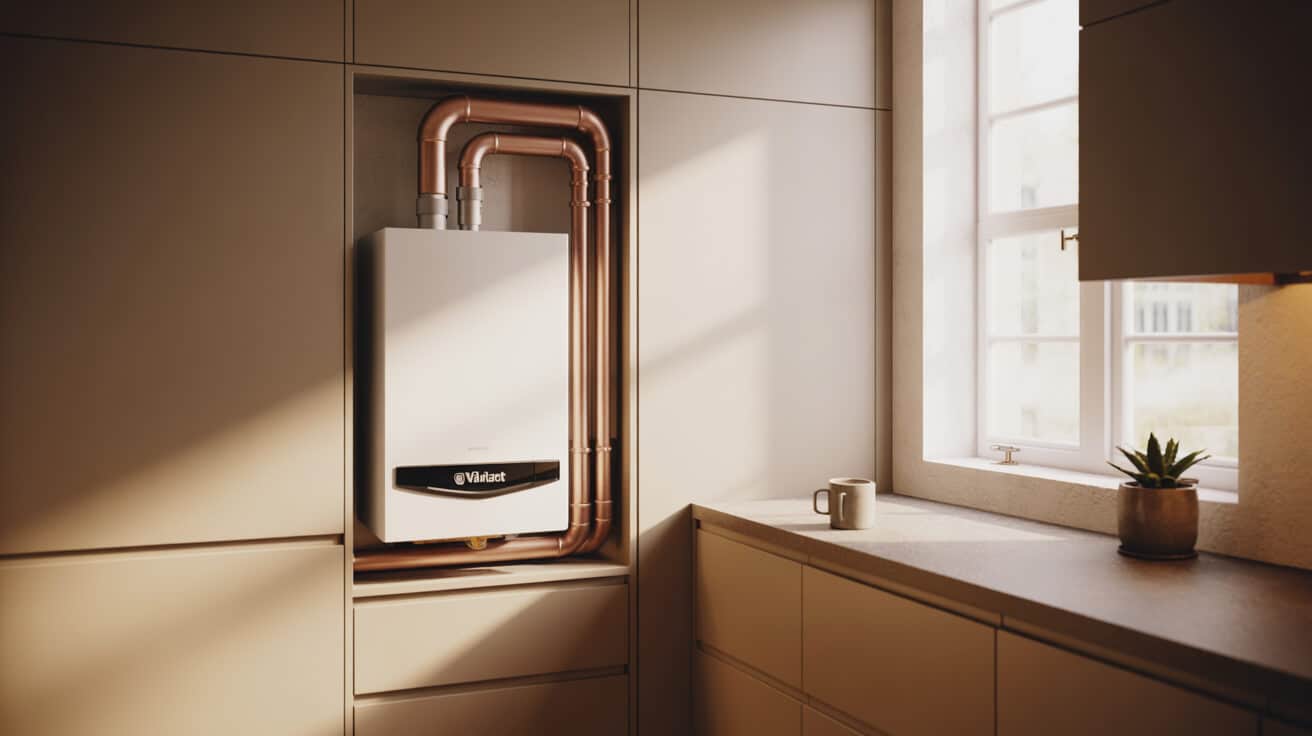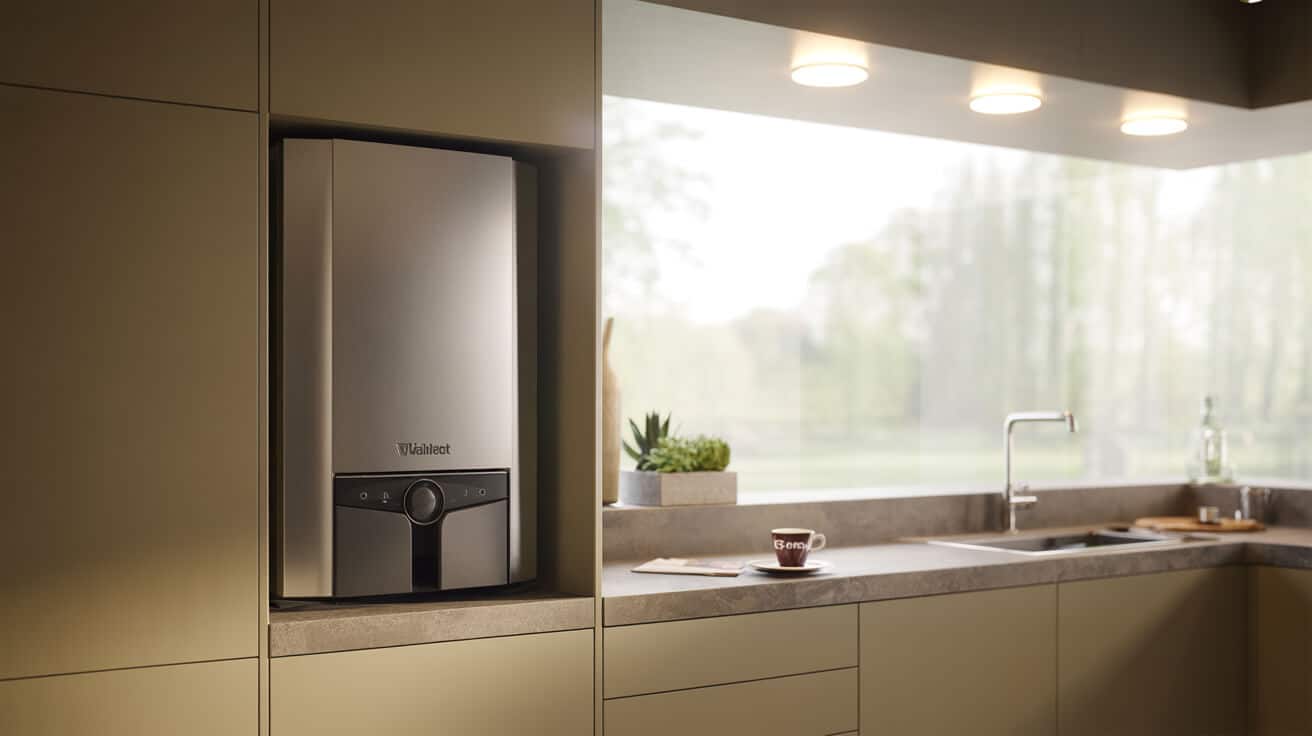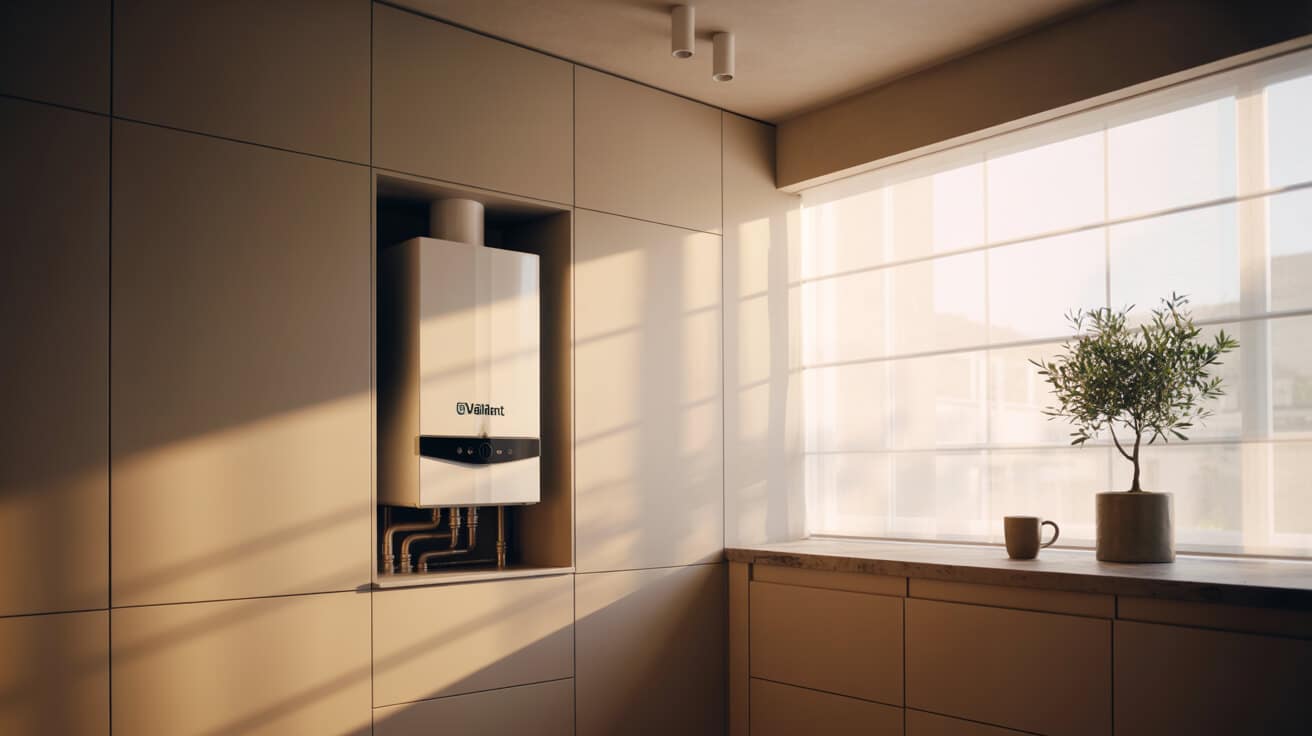The ecoTEC Plus family occupies a central position in the evolution of energy-smart space and water heating. Vaillant’s precision engineering fuses robust combustion management, low emissions, and flexible control across combi, system, and regular boiler formats. Adoption in UK housing, landlord portfolios, and managed properties is influenced by the system’s ability to satisfy current and pending efficiency regulations, deliver comfort at scale, and support advanced digital diagnostics. For your property or organisation, the range enables diverse installation pathways and ongoing cost minimization, supported by service plans and maintenance workflows trusted throughout the sector.
Etymology or name origin
The designation “ecoTEC” emerges from the thematic blend of “ecological” and “technology,” reflecting a brand commitment to lower environmental impact and technical innovation within heating appliances. “Plus” further signals tiered advancement, distinguishing these models from earlier or base variants by adding enhancement in control modulation, diagnostics, and external compatibility. Naming conventions capitalise on the European narrative of ecological modernization, positioning ecoTEC Plus as both a solution and a value statement for property modernizers and sustainability-focused organisations.
Overview and context
Condensing technology was propelled to the forefront of the UK and European heating market by regulatory and policy shifts mandating higher appliance efficiency and reduced environmental burden. Vaillant’s ecoTEC Plus is framed by these shifts, providing a modular solution for space and water heating that is compatible with a wide array of building archetypes. Its flexibility in installation, including compatibility with advanced smart controls, means your choice is future-ready and resolves both operational and compliance requirements without imposing on usable building space.
For property managers and facilities teams, Plumbers 4U professionals highlight how the ecoTEC Plus can be tailored to meet multi-tenant zoning, annual compliance reporting, and adaptive maintenance scheduling. The focus on achieving both SEDBUK and ErP “A-rating” underlines suitability for estate upgrades and high-turnover environments where reliability and asset protection are paramount.
History
Origins
The roots of gas central heating trace to the Victorian era, with the gradual standardisation of piped gas infrastructures and hydronic radiators. Early adoption prioritised open-flue, atmospheric boilers with modest efficiency.
Industrial emergence
Innovation during the late twentieth century was shaped by fuel crises, environmental policy activism, and rising consumer demands for cost reduction. Vaillant’s entry to the UK and EU markets introduced German manufacturing discipline, quality assurance, and component modularity, setting benchmarks for reliability and customer service in the industry.
Contemporary evolution
The ecoTEC Plus range was launched as part of Vaillant’s strategic response to the increasing stringency of Building Regulations, specifically Part L. Key developments included the introduction of digital user interfaces, learning algorithms for ignition and modulation, Quiet Mark accreditation, and extended modulation ratios. The portfolio expanded to embrace system and heat-only types, larger heat outputs, and new safety protocols. Smart home readiness and hybridization potential were incorporated in anticipation of property owner and regulatory trends.

Concept and description
Technical principles
At the core, the ecoTEC Plus leverages latent heat from exhaust gases, increasing total available energy through a condensing process. Key structural features include a high-turbulence stainless steel or aluminium heat exchanger, low-weight composite casing, and a microprocessor-regulated gas valve. System behaviour is governed by both onboard and external sensors, optimising combustion for weather, demand, and usage patterns.
Product formats
Combi boilers combine wet central heating and hot water supply, eliminating storage tanks and suitable for properties with limited utility space. System boilers interface with sealed cylinders, delivering higher hot water flow rates suitable for families or properties with multiple bathrooms. Regular (heat-only) boilers interface with vented systems or legacy piping common in older housing, maintaining serviceable output for larger radiated zones.
Features and differentiators
- Extended modulation (1:10 ratio): avoids energy waste at low demand points, enhancing eco performance and longevity.
- Integrated diagnostics: error code display and remote interface-compatible for rapid engineer assessment.
- Built-in frost protection, anti-cycling logic, and self-adjusting pump speed.
- Option packages: LPG conversion for off-grid properties, extended warranty, and compatibility with advanced filtration systems.
Functionality, purpose, and applications
Central heating and domestic hot water
Vaillant ecoTEC Plus models deliver efficient hydronic heat for radiators, underfloor circuits, and air handling units. The design incorporates dual temperature control loops where necessary, supporting both continuous trickle heating and rapid hot water demand. For your organisation, this means adapting energy usage to occupancy and zone, ensuring thermal comfort across workspaces and dwellings.
System flexibility
- Installation for new-build and retrofit projects—minimises disruption, preserves existing radiators and zones.
- Integration with digital and programmable thermostatic controls—improves thermal stability and reduces costs.
- Enablement of weather compensation logic and zone valves—adapts output to external and internal climate drivers.
- Facilitates low-emissions compliance for social housing portfolios, managed rental assets, and newly acquired commercial locations.
Adaptive applications
- On-demand system expansion—cascading mode for property extensions or multi-unit buildings.
- Redundant heat provision—multiple units can serve as failover in critical environments (e.g., care homes).
- Enhanced hydraulic circuits—compatibility with buffer tanks, plate heat exchangers, and specialist indirect water cylinders.
Classifications, types, and variants
Product typology
- Combi boilers: Instantaneous hot water, no storage tank. Models 825, 832, 835, 838, and 840, sized for typical UK property loads.
- System boilers: High flow, external storage. System 612, 615, 618, 624, 630, and 637 address multi-bath and large home scenarios.
- Regular boilers: Suited for open-vent and vintage system replacement. Regular 415, 418, 424, 430, and 435 cover legacy requirements.
Output and customization
| Variant | Output Range (kW) | Use Case | Hot Water Delivery |
|---|---|---|---|
| Combi | 12–38 | Flats to 4-bed homes | Instant, up to 20 l/min |
| System | 12–37 | Large family homes, small business | Cylinderdominated; multi-bath |
| Regular | 12–35 | Older, larger homes, multiple zones | Cylinder-based |
- LPG-Ready: Dedicated models for rural, off-grid or mobile properties.
- Cascade/parallel ready: Allows multiple installations for buildings with variable or high seasonal demand.
Selection criteria
Installation professionals, including Plumbers 4U, match model size and type to your building’s unique heat loss factors, water usage profile, and service access requirements—increasing lifetime efficiency and minimising out-of-warranty risk.
Systems, tools, and methodologies
Controls and interface
- Proprietary: vSMART, sensoCOMFORT, sensoHOME—support programmable timing, weather compensation, and learning algorithms.
- Third-party: Nest, Honeywell, Drayton, and other OpenTherm or relay-based stats extend user choice.
- Zoning: Wired and wireless options enable fine control in multi-room or multi-user environments.
Installation protocols
- Service provider professional assessment (gas supply, flue route, zone configuration).
- Adherence to Gas Safe and Benchmark processes, with G3 qualified personnel for unvented systems.
- Use of magnetic and chemical water treatment to reduce limescale and corrosion in all new and upgrade projects.
- System flushing and fill/pressurisation to prescribed parameters; detailed handover with user briefing.
Maintenance and diagnostics
- Annual service with flue gas analysis, system pressure check, and expansion vessel recharge.
- Error code retrieval through front panel interface and diagnostics apps—enables engineers to identify and resolve issues quickly.
- Ongoing support via digital service history for property managers seeking audit trail or compliance renewal.

Stakeholders and entities involved
Primary users and influencers
- Homeowners: Seek reliability, ease of use, low maintenance, and value retention for your home.
- Landlords and letting agents: Prioritise legal compliance, EPC uplift, and minimal void risk from heating downtime.
- Property and facilities managers: Demand longevity, digital tracking, and scalable support for portfolios.
- Installers and engineers: Rely on accessible installation manuals, rapid diagnostics, and certification standards.
- Suppliers and distributors: Provide product flow, replacement parts, and warranty fulfilment.
- Regulatory bodies: Enforce safe installation and verify ongoing compliance—Gas Safe Register, local authority inspectors.
Service ecosystem
Through proactive partnerships with established service networks—such as Plumbers 4U—installation, emergency response, and lifecycle maintenance streamline system performance, protect asset owners, and facilitate compliance.
Legal, regulatory, and ethical considerations
Regulatory environment
- Building Regulations (UK): All installations post-2005 must be condensing, with energy performance documented under Part L.
- Gas Safe Register: All installation, servicing, and repairs must be performed by registered engineers.
- Boiler Plus (2018): New and replacement boilers must feature advanced controls or load/thermal compensation.
- G3 (unvented systems): Installers require specialist certification; discharge routing and safety valves are regulated.
- Benchmark: Handover, commissioning, and ongoing maintenance documented in an installer-signed logbook.
Ethical practices
- Transparent maintenance and warranty protocols reduce likelihood of tenant complaints or regulatory intervention.
- Commitment to clear service quotes and explanation of optional upgrades (water softeners, smart controls, philtre advices) encourages informed asset management.
- Property managers who contract with trusted providers achieve higher rates of compliance, efficiency, and tenant satisfaction.
Risk mitigation
Ongoing property owner and manager responsibilities include annual servicing, performance data retention, and legal documentation—a standard feature of aftercare workflows established by Plumbers 4U.
Performance metrics, data, and measurements
Technical data
| Metric | Typical Range | Description |
|---|---|---|
| Efficiency (SEDBUK/ErP) | 89%–94% (A-rated) | Space heating and hot water efficiency |
| Heat output (kW) | 12–64 | Model specific; see typology |
| Modulation ratio | Up to 1:10 | Reduces energy use at low demand |
| Hot water flow (combi, l/min) | 10–20 | Delivery via mains, by model |
| Sound pressure (dB[A]) | 43–49 | Weighted operational average |
| Warranty (years) | 2–10 | Subject to annual servicing |
Life-cycle and maintenance
- Reliability: Hardware failure rates remain among the lowest in segment when annual service is maintained.
- Proactive diagnostics: Smart-enabled error code reporting and service logs minimise repair downtime.
- Market research: Ongoing manufacturer and service network evaluation is used to drive next-generation improvements and address field issues.
Environmental measurements
- Nitrogen oxide (NOx): Low-NOx burners ensure compliance with clean air regulation in urban deployment.
- Installer surveys report average annual cost savings of 20–30% over standard older boilers when deployed appropriately and maintained.
Challenges, barriers, and limitations
Operational challenges
- Retrofitting complexity: Integrating with legacy pipework may require adaptation.
- Water quality: Lack of inhibitors or water softening in hard water areas accelerates maintenance cycles.
- Installation quality: Incorrect flue siting, pressurisation, or commissioning can reduce expected lifespan and void the warranty.
Social and economic factors
- Upfront cost: Advanced technology and controls may entail higher initial expenditure, posing limitations for budget-constrained owners and smaller organisations.
- Regulation pace: Upcoming energy transitions may necessitate further upgrades—uncertainty in gas supply and policy impacts long-term investment confidence.
Philosophical and policy objections
- Environmental concerns: Gas combustion is under scrutiny as governmental Net Zero goals approach; preferences toward electrification and hybridization may change market dynamics.
- Accessibility: Vulnerable or elderly tenants require extra support in navigating digital controls and compliance protocols.
Impact, influence, and legacy
Industry contribution
- Market penetration: EcoTEC Plus has significant adoption rates in UK residential, landlord, and social housing markets.
- Technology transfer: Installer training, modular repair, and diagnostic protocols have set benchmarks for sector-wide professional development.
- Consumer experience: User reviews and independent studies report high satisfaction with maintenance predictability, ease of use, and thermal comfort levels.
Societal outcomes
- Elevated EPC scores: Portfolio-wide upgrades have driven improvements in national energy ratings, as tracked by property managers.
- Social housing strategy: Partnerships between suppliers and public sector property holders enable large-scale, standardised asset upgrades.
- Industry influence: Competitive product launches and regulatory changes have consistently tracked innovations pioneered by ecoTEC Plus in modulation, controls, and diagnostic logic.
Future directions, cultural relevance, and design discourse
Technological roadmaps
- Hydrogen blend readiness: Research and product development pivots toward accommodating future low-carbon fuel mixes.
- Hybrid system development: Incorporation of integrated controls for electric heat pumps and solar thermal boosts system flexibility.
- Modular innovations: Emphasis on wireless diagnostics, cloud-based monitoring, and adaptive user interfaces for property managers and multi-user dwellings.
Cultural significance
- Heating systems increasingly regarded as elements of property value, resilience, and tenant health.
- Climate discourse: The ongoing assessment of fossil fuel reliance in national energy planning positions upgrades and fuel-flexibility as key attributes.
Design and user experience
- Evolution toward intuitive, accessible user interfaces for all demographics.
- Anticipated further shift from proprietary to open-standard controls enhancing interoperability between property management systems and diverse vendor equipment.

